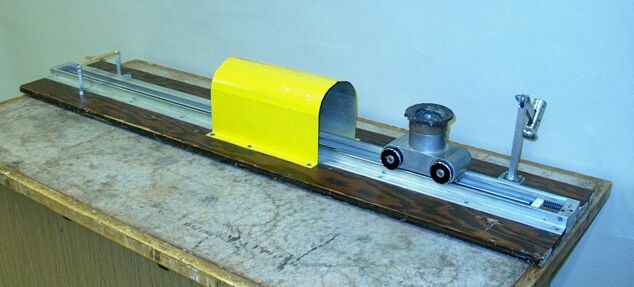
A video of this demonstration is available at this link.
A video of “Ball over Tunnel with Tilted Track” is available at this link.
A video of “Ball over Tunnel with Bell and Lamp” is available at this link.A 1″-diameter steel ball sits inside the stack of the cart, on a spring-loaded piston. By means of the plunger (at right, behind the track in the photograph above) press the ball down until you hear a click. Give the cart a push toward the tunnel. A catch releases the piston just before the cart enters the tunnel, launching the ball upward. Since the ball and the cart move with the same horizontal velocity, the ball flies over the tunnel and lands in the stack of the cart when the cart exits from the tunnel. To impress upon the class that in the reference frame of the cart the ball moves only vertically, it is a good idea to load the ball, then move the cart to where it just touches the catch. Moving the cart slightly toward the tunnel releases the ball, which flies straight upward and falls into the stack of the cart. Then you can perform the demonstration as described above. (Note: This is fairly easy to do, but it is possible to make two errors. If you push the cart too fast, the ball will hit the entrance of the tunnel on its way up, and if you push the cart too slowly, the ball will land on the tunnel.)
This demonstration is similar to 08.21 -- Simultaneous release, in that the ball moves with constant velocity in the x direction and experiences an acceleration in the y direction. In this demonstration, however, the ball starts out with an initial (upward) velocity in the y direction. The equations of motion are thus vx = constant (both cart and ball), vy = 0 (cart), and vy = vy0 - (1/2)gt (ball). From these, we also have x = vxt (both cart and ball) and y = vy0t - (1/2)gt2 (ball). Substituting t = x/vx into the equation for y, we get y = (vy0/vx)x - (g/(2vx2))x2. Since vy0, g and vx are constants, we can express this as y = Bx - Ax2, which, as for the ball shot out horizontally in the simultaneous release demonstration, is an equation of a parabola.
In the frame of reference of the cart, the ball’s horizontal velocity is zero, its only motion is vertical, and its entire motion is described by y = vy0t - (1/2)gt2. An observer moving with the cart would see the ball pop straight up from the stack, rise to some maximum height, then fall straight back into the stack. An outside observer sees that both the ball and the cart are moving horizontally with the same velocity while the ball is flying upward and falling back down.
For the two other versions of this demonstration, with tilted track and with bell and lamp, thanks are due to Prof. Don Marolf, who requested them. The version with tilted track, which requires only a pair of blocks, is readily available. The version with bell and lamp requires removal of the tunnel, and mounting of the rod with switches that close the circuits with the lamp and bell as the cart passes them.
Tilting the track provides an interesting and possibly surprising addition to the demonstration. Gravity acts on both the ball and the cart, at whatever angle you set the track. With the track level, it acts normal to the track, so the motion of the ball relative to the cart is vertical in both the cart’s reference frame and the laboratory reference frame. Whether the track is tilted or not, the forces of the launcher spring upward on the ball and downward on the cart, and the normal force of the track on the cart, are all normal to the track, and thus also to the line of motion of the cart. When the track is tilted, then, the relative motion of the ball and cart is still normal to the track and the line of motion of the cart, though it is no longer vertical in the laboratory reference frame. Thus, whether you send the cart downhill or push it uphill, the ball always lands in the cart.
The purpose of the bell and lamp in the third version of this demonstration, is to provide an audio-visual mark for the time it takes the cart to reach three different distances along the track, relative to when it is started. It shows that at constant velocity, from the start, the cart reaches one-third of the final distance, two-thirds of the final distance, and then the final distance, at equal time intervals. When you tilt the track so that the cart travels downhill, these intervals decrease as the cart progresses down the track. When you move the middle two switches so that their distances are now in ratios of 1:4:9 from the start, the time intervals are equal (or fairly close). From the equation of motion for an object under constant acceleration, stated above for the ball launched vertically, we see that if the object starts with zero velocity, its position is proportional to the square of the time. Hence the 1:4:9 ratios for the first three distances that correspond to equal time intervals.